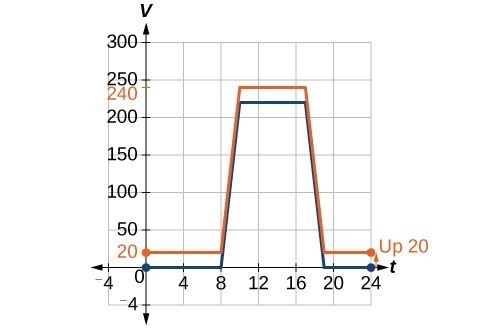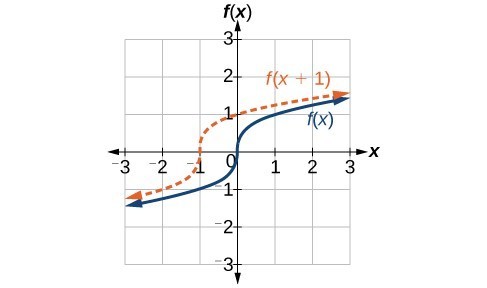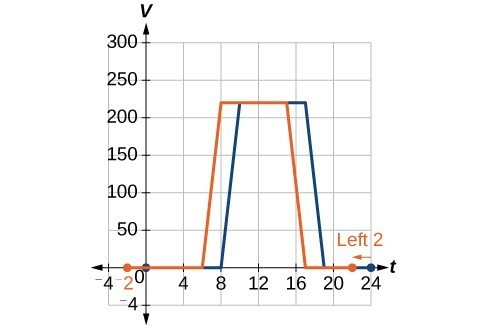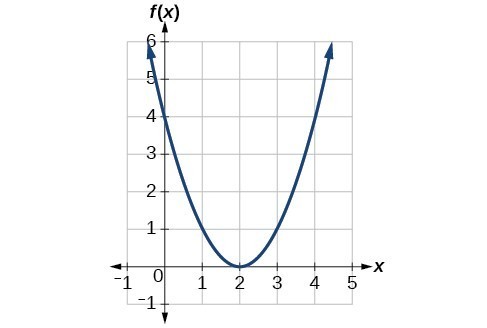Graph Shift To The Right
Often when given a problem, nosotros effort to model the scenario using mathematics in the form of words, tables, graphs, and equations. One method we can apply is to arrange the bones graphs of the toolkit functions to build new models for a given scenario. At that place are systematic ways to change functions to construct appropriate models for the problems we are trying to solve.
Identifying Vertical Shifts
One simple kind of transformation involves shifting the entire graph of a part upwards, down, right, or left. The simplest shift is a vertical shift, moving the graph up or down, considering this transformation involves calculation a positive or negative constant to the function. In other words, we add the same constant to the output value of the function regardless of the input. For a function, the function
is shifted vertically
units.

Figure 2. Vertical shift by
of the cube root function
.
To assist you visualize the concept of a vertical shift, consider that
. Therefore,
is equivalent to
. Every unit of
is replaced past
, so the
value increases or decreases depending on the value of
. The outcome is a shift upwards or downwardly.
A General Note: Vertical Shift
Given a function
, a new function
, where
is a abiding, is a vertical shift of the function
. All the output values change past
units. If
is positive, the graph will shift up. If
is negative, the graph will shift down.
Case ane: Adding a Abiding to a Function
To regulate temperature in a green building, airflow vents near the roof open and close throughout the twenty-four hour period. Figure 2 shows the surface area of open vents
(in square feet) throughout the twenty-four hours in hours afterward midnight,
. During the summer, the facilities manager decides to try to better regulate temperature by increasing the amount of open vents by 20 square feet throughout the twenty-four hours and night. Sketch a graph of this new function.
 Figure 3
Figure 3
Solution
Nosotros can sketch a graph of this new office by adding xx to each of the output values of the original function. This volition take the issue of shifting the graph vertically up, as shown in Figure 4.
 Figure 4
Figure 4
Notice that for each input value, the output value has increased past 20, so if nosotros call the new function
, we could write
This note tells us that, for any value of
can exist found past evaluating the office
at the same input and so adding 20 to the result. This defines
every bit a transformation of the function
, in this case a vertical shift up xx units. Notice that, with a vertical shift, the input values stay the same and only the output values change.
|
| 0 | eight | 10 | 17 | 19 | 24 |
|
| 0 | 0 | 220 | 220 | 0 | 0 |
|
| 20 | 20 | 240 | 240 | twenty | 20 |
How To: Given a tabular office, create a new row to represent a vertical shift.
- Identify the output row or column.
- Determine the magnitude of the shift.
- Add the shift to the value in each output cell. Add a positive value for up or a negative value for down.
Instance 2: Shifting a Tabular Office Vertically
A function
is given beneath. Create a table for the role
.
|
| 2 | four | 6 | viii |
|
| one | three | 7 | 11 |
Solution
The formula
tells us that we can observe the output values of
by subtracting three from the output values of
. For example:
Subtracting 3 from each
value, we can complete a table of values for
.
|
| 2 | 4 | half dozen | 8 |
|
| 1 | three | vii | 11 |
|
| −2 | 0 | 4 | 8 |
The function
gives the pinnacle
of a brawl (in meters) thrown upward from the ground after
seconds. Suppose the ball was instead thrown from the elevation of a 10-1000 building. Chronicle this new height office
to
, and then observe a formula for
.
Identifying Horizontal Shifts
We just saw that the vertical shift is a change to the output, or outside, of the office. We will now look at how changes to input, on the inside of the office, change its graph and meaning. A shift to the input results in a movement of the graph of the function left or right in what is known as a horizontal shift. 
Figure 5. Horizontal shift of the role
. Annotation that
shifts the graph to the left, that is, towards negative values of
.
For example, if
, then
is a new function. Each input is reduced past 2 prior to squaring the function. The result is that the graph is shifted ii units to the correct, because we would need to increment the prior input by 2 units to yield the same output value every bit given in
.
A General Annotation: Horizontal Shift
Given a function
, a new function
, where
is a constant, is a horizontal shift of the function
. If
is positive, the graph volition shift right. If
is negative, the graph will shift left.
Example 3: Calculation a Abiding to an Input
Returning to our building airflow example from Example 2, suppose that in fall the facilities manager decides that the original venting plan starts too late, and wants to begin the entire venting program 2 hours earlier. Sketch a graph of the new function.
Solution
We tin can set
to be the original plan and
to be the revised program.
In the new graph, at each fourth dimension, the airflow is the same equally the original function
was 2 hours subsequently. For example, in the original function
, the airflow starts to change at eight a.grand., whereas for the function
, the airflow starts to change at vi a.m. The comparable function values are
. Find also that the vents first opened to
at 10 a.grand. nether the original plan, while nether the new plan the vents reach
at 8 a.m., so
.
 Figure six
Figure six
In both cases, we meet that, because
starts ii hours sooner,
. That means that the same output values are reached when
.
How To: Given a tabular office, create a new row to represent a horizontal shift.
- Identify the input row or column.
- Determine the magnitude of the shift.
- Add the shift to the value in each input prison cell.
Example iv: Shifting a Tabular Function Horizontally
A function
is given below. Create a table for the office
.
|
| 2 | iv | 6 | 8 |
|
| 1 | iii | vii | 11 |
Solution
The formula
tells us that the output values of
are the same as the output value of
when the input value is iii less than the original value. For example, we know that
. To go the aforementioned output from the function
, nosotros will need an input value that is iii larger. We input a value that is 3 larger for
because the function takes iii away before evaluating the function
.
We keep with the other values to create this tabular array.
|
| 5 | 7 | nine | 11 |
|
| ii | 4 | 6 | 8 |
|
| 1 | 3 | 7 | xi |
|
| 1 | 3 | 7 | 11 |
The outcome is that the function
has been shifted to the right by 3. Notice the output values for
remain the same equally the output values for
, but the corresponding input values,
, have shifted to the correct by iii. Specifically, ii shifted to 5, 4 shifted to seven, 6 shifted to 9, and eight shifted to eleven.
Example 5: Identifying a Horizontal Shift of a Toolkit Role
This graph represents a transformation of the toolkit function
. Relate this new function
to
, and then find a formula for
.
 Figure 8
Figure 8
Solution
Observe that the graph is identical in shape to the
function, simply the ten-values are shifted to the right 2 units. The vertex used to exist at (0,0), but now the vertex is at (2,0). The graph is the basic quadratic function shifted 2 units to the right, so
Notice how we must input the value
to get the output value
; the x-values must be 2 units larger because of the shift to the correct by 2 units. We can then use the definition of the
function to write a formula for
by evaluating
.
Instance 6: Interpreting Horizontal versus Vertical Shifts
The role
gives the number of gallons of gas required to drive
miles. Translate
and
.
Solution
can be interpreted as adding 10 to the output, gallons. This is the gas required to drive
miles, plus another 10 gallons of gas. The graph would betoken a vertical shift.
can be interpreted as adding 10 to the input, miles. So this is the number of gallons of gas required to drive 10 miles more than
miles. The graph would indicate a horizontal shift.
Try Information technology 1
Given the function
, graph the original function
and the transformation
on the same axes. Is this a horizontal or a vertical shift? Which way is the graph shifted and past how many units?
Solution
Licenses and Attributions
Graph Shift To The Right,
Source: https://www.coursehero.com/study-guides/ivytech-collegealgebra/graph-functions-using-vertical-and-horizontal-shifts/
Posted by: curranyoughthears.blogspot.com


0 Response to "Graph Shift To The Right"
Post a Comment